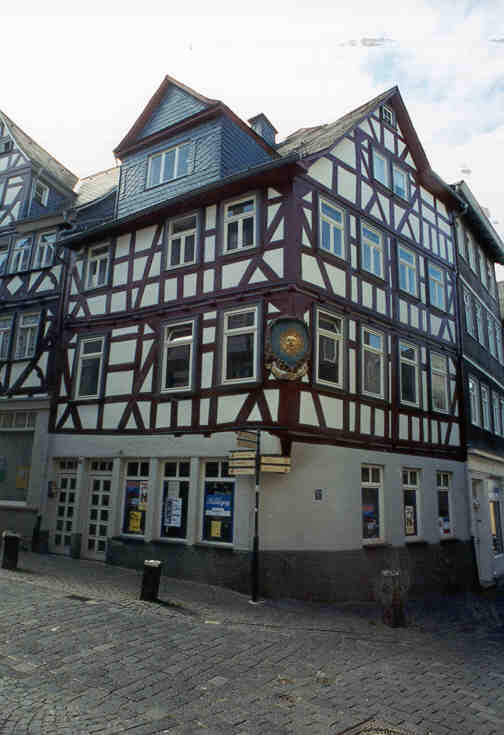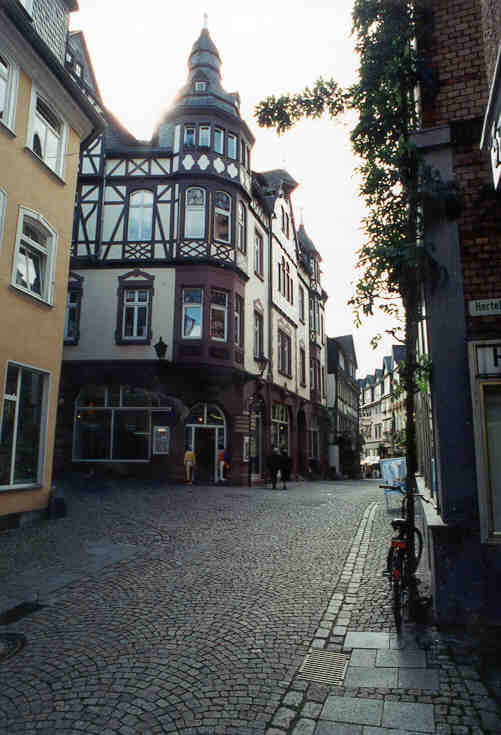
Click here to go to the main Germany web page. Click here to go to the Munich Octoberfest page. Click here to go to the Stuttgart page. Click here to go to the Heidelberg page.
Leitz started the 35mm still camera movement in Wetzlar with the design with the introduction of the Leica camera, way back in the 1920s. Other "small format" cameras using 35mm movie film were unsuccessfully introduced before the first Leica, but the Leica was such a hit in the marketplace that Leica is considered the first real 35mm camera.

Yet another cool old building in Wetzlar.
The town's first streetlamp was here, and the streetlamp is commemorated by the Seal on this building's corner.
I shot all my photos in Wetzlar on 35mm film. There are a couple of good reasons for this. First, I didn't want to lug around anything bigger. Second, 35mm is great for wide-angle work and Europe tends to be a place where a wide-angle lens is a handy thing to have. The streets are narrow in Wetzlar, so it's usually impossible to back up enough to frame a building or street scene. My plan was to shoot these kinds of shots, so the choice of using 35mm gear was almost automatic.
I used my old Canon FTb and a 20mm/f2.8 lens for almost all of the shots I took in Germany, including Wetzlar. I shot mostly Kodak Royal Gold film. I didn't bring a tripod, but I would have liked to have one. Since I was not checking any baggage I was worried that the airport security nazis would have gotten nervous about a tripod. After all, you can't bring a hockey stick aboard in your carry on any longer, and my logic was that it's just as easy to hijack an aircraft with a tripod as with a hockey stick.
Shooting high-angle photos with a 35mm camera introduces some wicked distortion of perspective. What I mean is, the bottoms of the buildings are rendered as very wide and the tops of the buildings look like they're a long way off in the distance. 35mm cameras don't have any way to correct for this distortion the way that large format cameras do. Someday I might make an attempt to correct the perspective in the darkroom, but for now I'm pleased with the dramatic look of the shots. To illustrate the prespective distortion, compare this shot with this one. Notice how the cathedral seems to "lean back"?
I had my local grocery store develop my film and print a set of proofs for me. Lon, who runs the Fuji mini-lab at the grocery store, is competent and quick. He tells me that it's a nice break for him to develop the outdoor photographs that I take, as opposed to the unending drugery of baby pictures he gets every day. And, the Fuji equipment is high quality, so I can rely on Lon to deliver the goods. Finally, the cost is cheap-$4.00 for thirty six exposures, with 3x5 prints. I recommend that any photographer who cares about quality cultivate a good working relationship with his or her mini-lab operator. It's worth the effort.
I don't own a scanner, so I come in to work early and use my department's flatbed. My attitude towards digital photography is that it's a necessary evil as long as I want to put images into web pages, so I put a very minimal effort into scanning my work. My lack of effort shows-my scans suck. However, I'm enough of a photo-snob to write it off. A "real" photographer, the story goes, shoots slides and then projects them. A less than serious photographer would make good prints and spend serious effort on his scans. I, by contrast, am a lazy slob. My motto is "Hard work pays off in the long run, but laziness pays off each and every day".

Parting shot: Backlit turret above a bookshop on a winding street in Wetzlar.
Wetzlar Page 1 Wetzlar page 2 Wetzlar Page 3